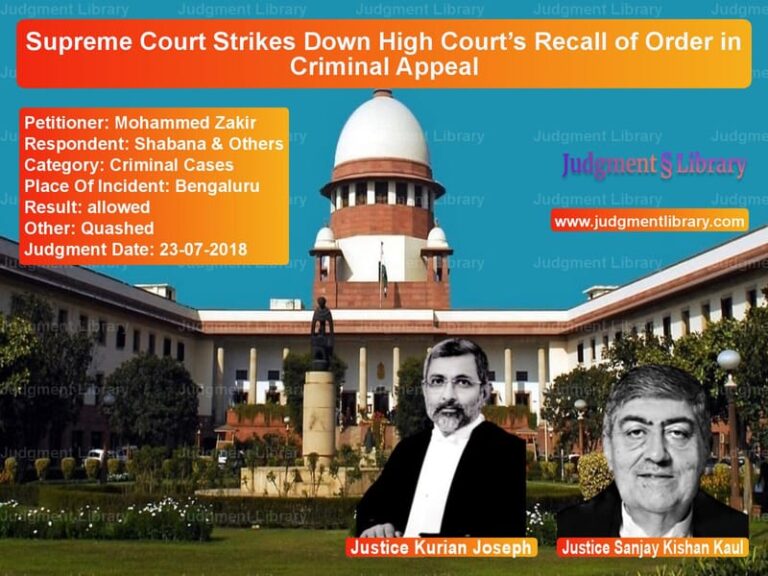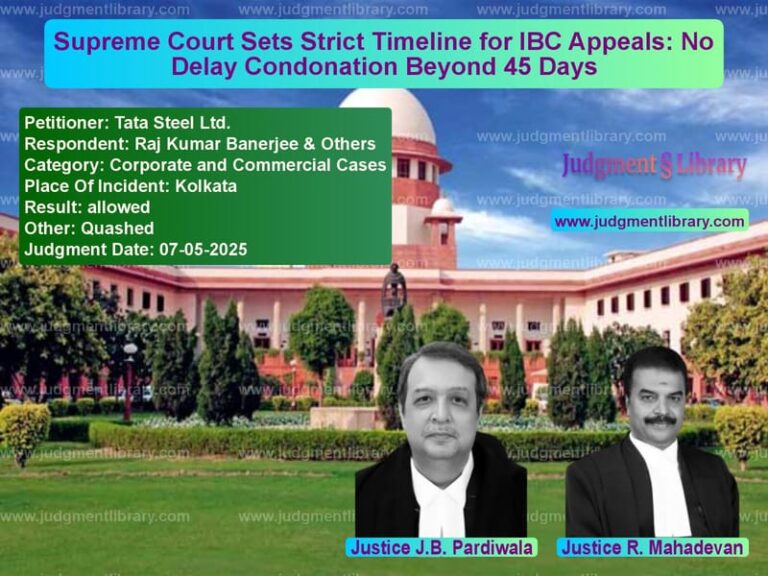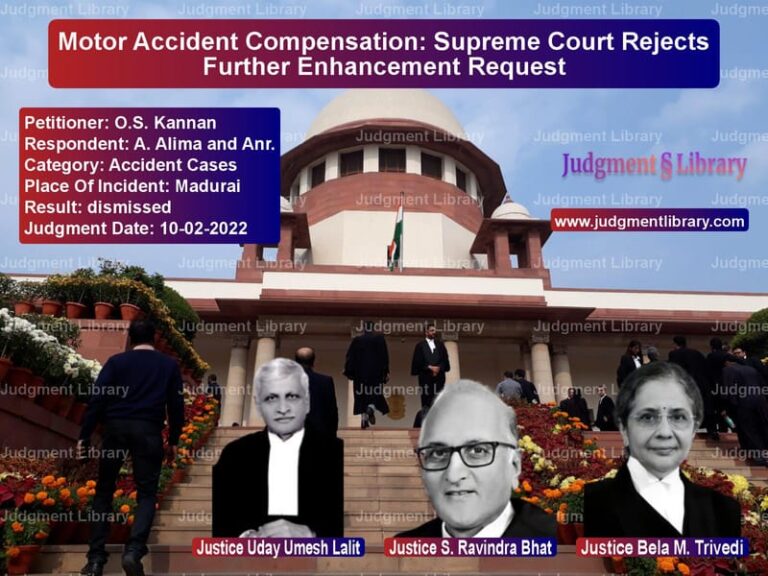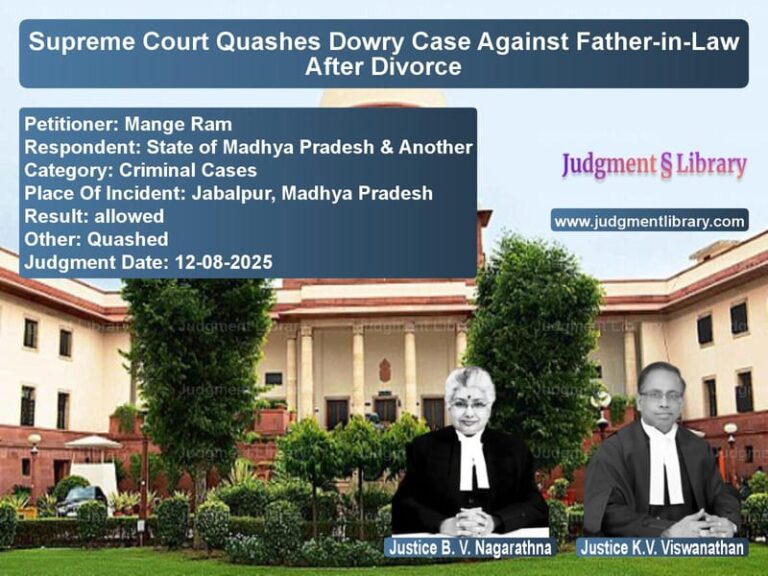Acquittal in Capital Punishment Case: Supreme Court Overturns Conviction Due to Flaws in Evidence
The case of Irfan @ Naka vs. The State of Uttar Pradesh has gained significant legal attention due to its implications for capital punishment and evidentiary standards in criminal trials. The Supreme Court overturned the death sentence awarded to the appellant-convict due to inconsistencies in the prosecution’s case, particularly in the dying declarations and eyewitness testimonies.
Background of the Case
The appellant-convict, Irfan @ Naka, was accused of murdering his own son and two brothers by setting them on fire while they were asleep. The trial court convicted him under Sections 302 (murder), 436 (mischief by fire), and 326-A (causing grievous hurt by use of acid) of the Indian Penal Code (IPC), sentencing him to death. The conviction was upheld by the High Court of Allahabad, which also confirmed the death penalty.
However, upon appeal, the Supreme Court scrutinized the case and found serious flaws in the prosecution’s evidence, leading to the appellant’s acquittal.
Case Timeline
- 2014: Incident occurred; three victims sustained severe burn injuries.
- 2014-2015: Victims died due to burn injuries; prosecution built the case against the appellant based on dying declarations.
- 2018: Trial court convicted the appellant and awarded a death sentence.
- 2018: High Court confirmed the death penalty.
- 2023: Supreme Court acquitted the appellant due to inconsistencies in evidence.
Arguments by the Appellant
The appellant’s counsel, Mr. Gopal Sankaranarayanan, made the following arguments:
- The case was based entirely on circumstantial evidence, and no direct proof linked the appellant to the crime.
- The two dying declarations of the victims were unreliable and inconsistent.
- The investigating officer did not follow proper procedures in recording the dying declarations, and no magistrate was called to oversee them.
- The prosecution’s key witnesses, PW-2 and PW-4, provided conflicting statements.
- Medical evidence suggested the victims were in critical condition and might not have been in a state to make coherent declarations.
Arguments by the Respondent (State of Uttar Pradesh)
The State, represented by Mr. Ardhendumauli Kumar Prashad, argued:
- The appellant had a strong motive for committing the crime due to family disputes.
- The dying declarations were valid and corroborated by eyewitness testimony.
- The appellant had a history of criminal activity.
- Both the trial court and High Court found the evidence sufficient to convict the appellant.
Key Observations by the Supreme Court
The Supreme Court critically examined the evidence and made the following key observations:
“We are left with either to believe the dying declarations or the oral evidence of the two so-called eye-witnesses. It is also important to note that the PW-4, in her cross-examination, stated that to the best of her knowledge, the victims had fastened the latch from inside. If the door of the room was closed from inside, how did the appellant manage to enter and set the room on fire?”
Additionally, the Court noted:
“If PW-2 and PW-4 were present at the time of the incident and they opened the door to rescue the victims, why do their names not appear in the dying declarations?”
The contradictions in witness statements and the procedural lapses in recording the dying declarations created reasonable doubt in the case.
Legal Precedents Cited
The Supreme Court relied on several precedents to reinforce its decision:
- Muthu Kutty & Anr. v. State of Tamil Nadu (2005) 9 SCC 113: Highlighted the need for caution in accepting dying declarations.
- Nallapati Sivaiah v. Sub-Divisional Officer (2007) 15 SCC 465: Emphasized that a dying declaration must be free from doubt.
- Sujit Biswas v. State of Assam (2013) 12 SCC 406: Stressed that suspicion, no matter how strong, cannot replace proof beyond reasonable doubt.
Final Judgment
Given the inconsistencies in evidence, the Supreme Court ruled:
“It is unsafe to record a conviction based solely on the dying declarations, especially when they contradict the oral evidence of eyewitnesses. The prosecution has failed to prove its case beyond reasonable doubt.”
The Court acquitted the appellant and directed his immediate release.
Conclusion
The Supreme Court’s decision in Irfan @ Naka vs. The State of Uttar Pradesh underscores the importance of procedural fairness in capital cases. It reinforces that a conviction must be based on solid evidence, free from inconsistencies. This judgment serves as a crucial precedent in ensuring that justice is served with due diligence, particularly in cases involving the death penalty.
Petitioner Name: Irfan @ Naka.Respondent Name: State of Uttar Pradesh.Judgment By: Justice B.R. Gavai, Justice J.B. Pardiwala, Justice Prashant Kumar Mishra.Place Of Incident: Bijnore, Uttar Pradesh.Judgment Date: 23-08-2023.
Don’t miss out on the full details! Download the complete judgment in PDF format below and gain valuable insights instantly!
Download Judgment: irfan-@-naka-vs-state-of-uttar-prade-supreme-court-of-india-judgment-dated-23-08-2023.pdf
Directly Download Judgment: Directly download this Judgment
See all petitions in Murder Cases
See all petitions in Bail and Anticipatory Bail
See all petitions in Judgment by B R Gavai
See all petitions in Judgment by J.B. Pardiwala
See all petitions in Judgment by Prashant Kumar Mishra
See all petitions in allowed
See all petitions in supreme court of India judgments August 2023
See all petitions in 2023 judgments
See all posts in Criminal Cases Category
See all allowed petitions in Criminal Cases Category
See all Dismissed petitions in Criminal Cases Category
See all partially allowed petitions in Criminal Cases Category







